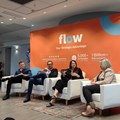Google will discontinue cookies in the third quarter of 2024.

Image supplied. Gil Sperling, co-founder and CEO of data-driven adtech company, Flow, in his keynote speech at PPW in Bangkok, Thailand
With Google's announcement that it will phase out cookies in the third quarter of 2024, in response to increasingly strict regulations and growing concerns about data privacy, the era of third-party cookies is coming to an end.
While this, together with the convergence of stringent laws and heightened data privacy concerns, means that portals and marketplaces need to get to grips with this shift, it also presents an opportunity to capitalise on the massive revenue that it presents.
However, the necessity for user consent remains, and businesses are turning to first-party data as the solution for growth in a cookieless world.
According to research by Deloitte, 61% of high-growth companies are already transitioning to a first-party data strategy, thereby accelerating marketplaces and portals to emerge as the new media giants.
This is according to Gil Sperling, co-founder and CEO of data-driven adtech company, Flow, in his keynote speech at PPW in Bangkok, Thailand.
A recalibration of strategies
Relying on third-party cookies for insight into consumers is fast disappearing and have been replaced by first-party data trends and opportunities.
For consumers, this heralds a new era of empowerment, offering heightened privacy, control, and more explicit consent.
For marketers and media professionals, however, this seismic change demands a recalibration of strategies.
“First-party data is the new oil of the digital landscape and has become the most valuable asset in a marketer’s arsenal,” says Sperling.
First-party data strategies
Marketing budgets are shifting toward first-party data strategies and that is where the opportunity lies.
Just look at retail giants, with thousands of brands on their shelves, who have been using their first-party data to target audiences off-site for years and have proved the value of the retail media model.
This paves the way for anyone with first-party data, such as portals and marketplaces, and/or their own insight on consumer behaviour to do the same.
Retail media
“According to Retail Touchpoints’ research, every one of the top 10 retailers in the US has a retail media network in place, while eMarketer reports that 58% of media decision-makers are already using retail media to inform their media strategies,” Sperling adds.
“In 2024, retail media in the US could represent one in every five digital ad dollars, and according to AdExchange, global retail media revenue is forecast to grow 8.3% this year.”
Take Walmart for example, the well-known budget-friendly convenience store in the US that is now able to reach 150 million+ shoppers every week by utlising first-party data.
Or Etsy, the online marketplace for crafts, fashion or any imaginable item for sale, that is able to connect off-site to users on Google, Facebook, Instagram, Bing and Pinterest, where user count is sizable and frequent, simply through targeted advertising.
“What this means is that anyone with first-party data can do the same, including portals and marketplaces,” says Sperling.
Unlock new revenue streams
“Furthermore, portals and marketplaces can now unlock new revenue streams by packaging and selling segments of their first-party audience data to brands like insurers, moving companies, internet providers, mortgage brokers and more.”
“The time is now. Cookies have crumbled, and anyone with first-party data can unlock more revenue by being a data giant and creating their very own data ecosystem.
"They can enable their endemic clients, such as existing suppliers or agents, to utilise this data to effectively target their ideal audience on social media platforms.
"They can also package and sell segments of their first-party audience data to non-endemic clients, such as brands, thereby tapping into exponential revenue growth opportunities," he explains.




































